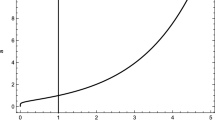Abstract
In this paper, we explore the relationship between holographic Wilsonian renormalization groups and stochastic quantization in conformally coupled scalar theory in AdS\(_{4}\). The relationship between these two different frameworks is first proposed in arXiv:1209.2242 and tested in various free theories. However, research on the theory with interactions has recently begun. In this paper, we show that the stochastic four-point function obtained by the Langevin equation is completely captured by the holographic quadruple trace deformation when the Euclidean action \(S_{E}\) is given by \(S_{E}=-2I_{os}\) where \(I_{os}\) is the holographic on-shell action in the conformally coupled scalar theory in AdS\(_{4},\) together with a condition that the stochastic fictitious time t is also identified with AdS radial variable r. We extensively explore a case that the boundary condition on the conformal boundary is Dirichlet boundary condition, and in that case, the stochastic three-point function trivially vanishes. This agrees with that the holographic triple trace deformation vanishes when Dirichlet boundary condition is applied on the conformal boundary.
Similar content being viewed by others
Notes
The authors consider a more general boundary condition on AdS boundary and its stochastic frame but they discuss the issues only in zero boundary momenta case [17].
References
O. Aharony, S.. S. Gubser, J.. M. Maldacena, H. Ooguri, Y. Oz, Phys. Rept. 323, 183–386 (2000). https://doi.org/10.1016/S0370-1573(99)00083-6
J.M. Maldacena, Adv. Theor. Math. Phys. 2, 231–252 (1998). https://doi.org/10.4310/ATMP.1998.v2.n2.a1
L. Susskind, E. Witten, arXiv:hep-th/9805114 [hep-th] (1998)
T. Faulkner, H. Liu, M. Rangamani, JHEP 08, 051 (2011). https://doi.org/10.1007/JHEP08(2011)051
T. Faulkner, J. Polchinski, JHEP 06, 012 (2011). https://doi.org/10.1007/JHEP06(2011)012
G. Lifschytz, V. Periwal, JHEP 04, 026 (2000). https://doi.org/10.1088/1126-6708/2000/04/026
D. Polyakov, Class. Quant. Grav. 18, 1979 (2001). https://doi.org/10.1088/0264-9381/18/10/311
D.S. Mansi, A. Mauri, A.C. Petkou, Phys. Lett. B 685, 215–221 (2010). https://doi.org/10.1016/j.physletb.2010.01.033
G. Parisi, Y.S. Wu, Sci. Sin. 24, 483 (1981)
J.H. Oh, D.P. Jatkar, JHEP 1211, 144 (2012). https://doi.org/10.1007/JHEP11(2012)144
J.H. Oh, Phys. Rev. D 94(10), 105020 (2016). https://doi.org/10.1103/PhysRevD.94.105020
J.H. Oh, Int. J. Mod. Phys. A 29, 1450082 (2014). https://doi.org/10.1142/S0217751X14500821
S.P. Moon, Int. J. Mod. Phys. A 33(16), 1850091 (2018). https://doi.org/10.1142/S0217751X18500914
J.H. Oh, J. Korean Phys. Soc. 79(10), 903–917 (2021). https://doi.org/10.1007/s40042-021-00320-x
J.H. Oh, JHEP 11, 100 (2020). https://doi.org/10.1007/JHEP11(2020)100
J.H. Oh, Int. J. Mod. Phys. A 30(17), 1550098 (2015). https://doi.org/10.1142/S0217751X15500980
G. Kim, J. S. Chae, W. Sin, J. H. Oh, arXiv:2305.18920 [hep-th] (2023)
Acknowledgements
J.H.O thanks his W.J. and Y.J. and he thanks God. This work was supported by the National Research Foundation of Korea(NRF) grant funded by the Korea government(MSIT) (No.2021R1F1A1047930).
Author information
Authors and Affiliations
Corresponding author
Additional information
Publisher's Note
Springer Nature remains neutral with regard to jurisdictional claims in published maps and institutional affiliations.
Rights and permissions
Springer Nature or its licensor (e.g. a society or other partner) holds exclusive rights to this article under a publishing agreement with the author(s) or other rightsholder(s); author self-archiving of the accepted manuscript version of this article is solely governed by the terms of such publishing agreement and applicable law.
About this article
Cite this article
Lee, J.H., Oh, JH. Stochastic quantization and holographic Wilsonian renormalization group of conformally coupled scalar in AdS\(_{4}\). J. Korean Phys. Soc. 83, 665–674 (2023). https://doi.org/10.1007/s40042-023-00926-3
Received:
Accepted:
Published:
Issue Date:
DOI: https://doi.org/10.1007/s40042-023-00926-3




